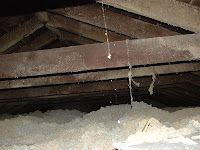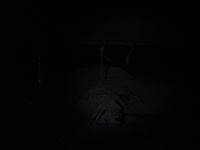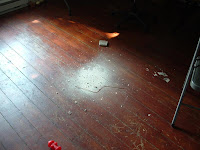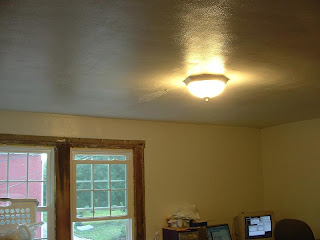Oh my.
So except for actually installing the circuit breakers, the baseboard heat is installed, and not a minute too soon; the wind was getting a little chilly today. The carriage house holds heat rather well, I'm pleased to say, but it still needs some heat to hold. (I believe I mentioned that I had an HVAC guy - who happened to graduate high school with me - examine all three furnaces on the property; happily, they're all in pretty decent shape. The two in the big house need a new flue, though; the old one is horribly corroded because there's no liner in the chimney. More on that later.)
So the electrical inspector will be here on Wednesday, after which: heat.
But as long as we're doing electrical work, my wife says, "You know, a civilized apartment's living room should have an overhead light." Given that the carriage house apartment was built around 1948, they had gone with the newfangled idea of putting a switched outlet in the living room. Sigh. I hate switched outlets. They're really irritating for use with computers.

So this weekend's big task turned out to be: into the attic! The goal: unswitch the switched outlet, and use the switch for an overhead light.

The view looking south explains rather well why the carriage house holds its heat: there is about eight inches of blown-in cellulose goodness up there. Makes it really dirty to do electrical work, though.

And of course that shot has a
flash, so it doesn't really do justice to what I have to work in, which looks more like this picture here, taken with flashlight lighting only. We have better flashlights. Somewhere. In a box downstairs. So I made do.

Anyway, I didn't take thorough pictures, but after some thought and experimentation, I pulled the old box out of the wall for the old outlet, leaving a hole large enough to reach in for the wires down from the attic. I spliced the switch wire onto a new wire going up, and ran a new power wire down for the outlet. Left the old wire in the wall.
By "old wire" I mean old wire. It's about the size of a garden hose, but the gauge of the actual wire seems smaller than the 12-2 I'm using elsewhere. The remainder is tar-soaked fabric on each strand, a layer of paper, two strands of twine (for tensile strength?), more paper, and another layer of tarry fabric. Even the electrical tape was fabric. No plastic at all; fascinating!

It still spliced nicely with standard electrical nuts, though. Here's a nice shiny electrical box, showing the old wire coming in on the top and the switch wire on the right side. The coil is still attached to the top end of the power line I pulled down for the outlet. I had to buy a longer drill bit to make it down through the top of the wall -- most of it was two 2x4's on top, but of course over the outlet box it was three.
In the process of drilling through the top of the wall, though, I managed to look down on the box of one of the thermostats I installed last week. That was kinda cool!

Anyway, once that was done and the wires fished through, I drilled a hole in the ceiling and poked a wire up through it so I could find it in the attic. Then it was back to the attic, keyhole saw in hand, and eventually, I had a nice square hole to insert my light box in. This was surprisingly tiring.
Once the box fit, I cut a 2x4 to length and hammered it between the joists. It fit so tight I didn't even bother nailing it in place; it's never going to move again.

Here it is from the bottom side, on the ceiling of the front room. It ended up being a tad too low, but I kid you not, I couldn't move the 2x4 back up. It's in that tight. And it's only about an 1/8 of an inch too low, so it isn't really worth the effort. Besides, the light fixture mounted to it OK, so I guess it is officially Good Enough.

Made a nice little mess on the living room floor. Not the first, probably not the last.

The result is well worth it. Also, having one outlet in this place with a ground prong is a good start.


